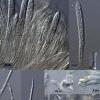
24-12-2025 17:08
Hulda Caroline HolteHello, I have found this propoloid ascomycete on

21-12-2025 09:32
Hello.A tiny ascomycete found embedded in wood in

21-12-2025 21:32
Pol DebaenstHello, Garden, Burgweg 19, Veurne, BelgiumOn 10/1

22-12-2025 23:38
Patrice TANCHAUDBonsoir, récolte sur un mur en pierre, apothéci

22-12-2025 00:47
Patrice TANCHAUDBonsoir, récolte à proximité du milieu dunaire
Coccomyces on Quercus leaves
Garrido-Benavent Isaac,
24-02-2014 18:47
This is a Coccomyces that was growing on dead leaves of Q. ilex subs. rotundifolia and Q. coccifera, in eastern Spain at around 200 m asl.
Following a key shared by B. Declercq here in Ascofrance, I'm not quite sure if my specimens belong to C. dentatus or C. coronatus. Macroscopically, they are more related to the former, microscopically to the later though. Perhaps there are other "intermediate species" which weren't included in that key.
Some of the traits that could help to identify it are:
- Spores 63-87 x 2'5-3'3(4) um, with one rounded end and the other somewhat sharpened, abundant granular content.
- Asci between 95-120 x 9-11 um.
- Paraphyses with more or less clavate tips, straight or slightly curved, surrounded by gel and 3-4 um width.
- Macroscopically, there can be seen 3 to 5 black, irregular teeth. Ascocarp diameter not exceeding 1mm diameter. Hymenium whitish to ivory. Despite I've not studied it yet, there are some black, smaller dots around the ascocarps that could be pycnidia.
Any suggestion will be appreciated!!
Cheers
Isaac

